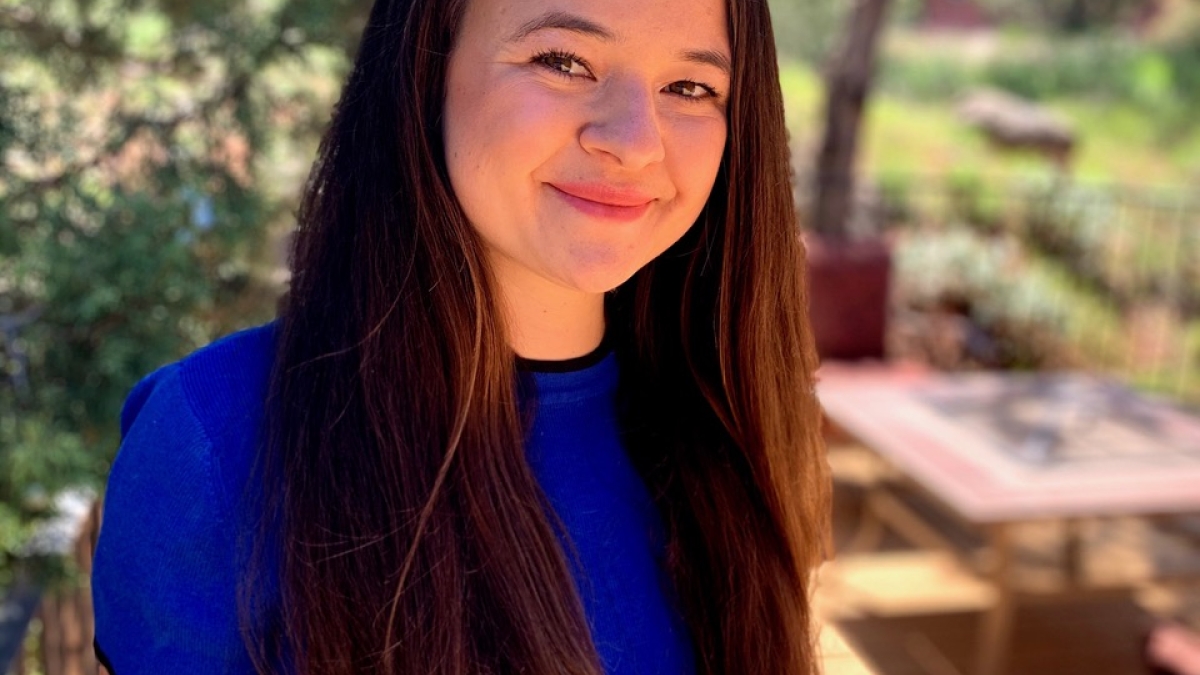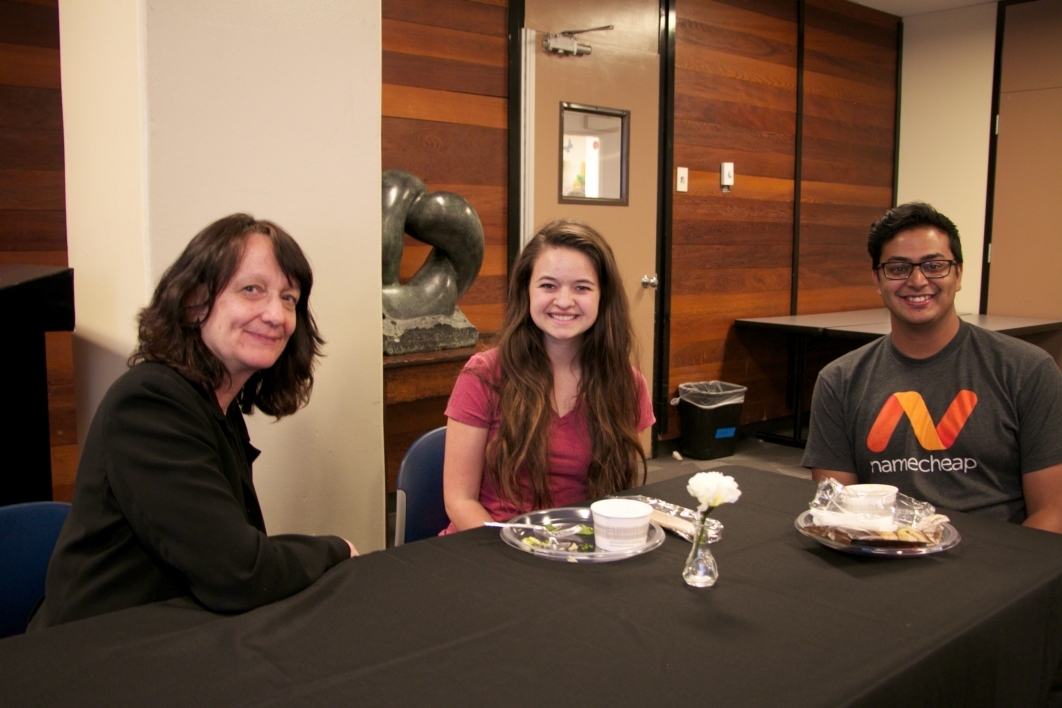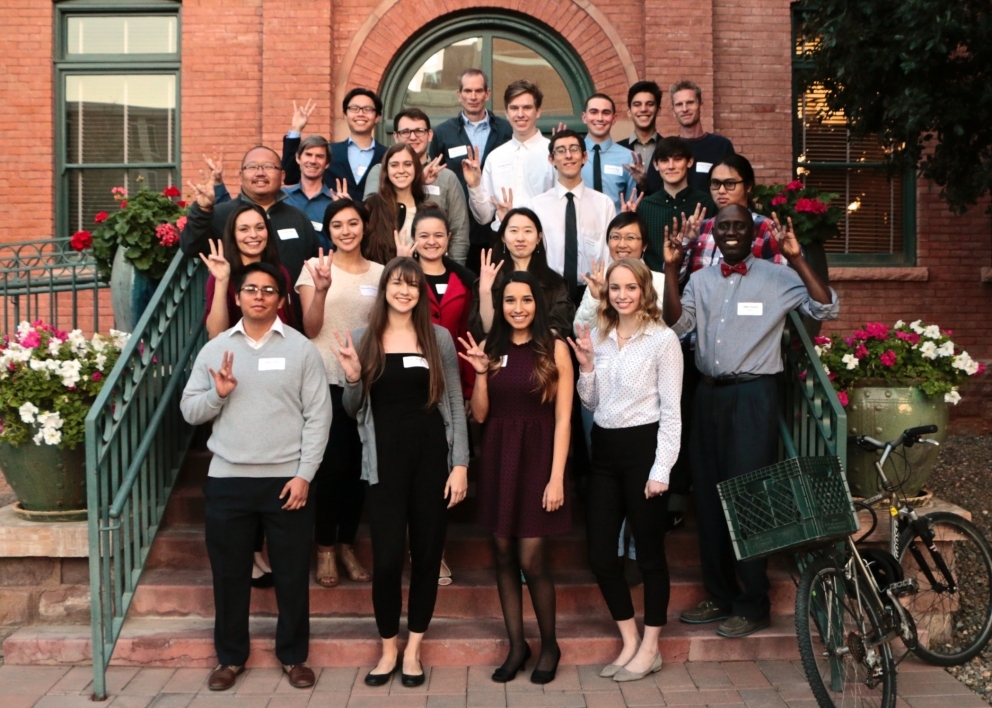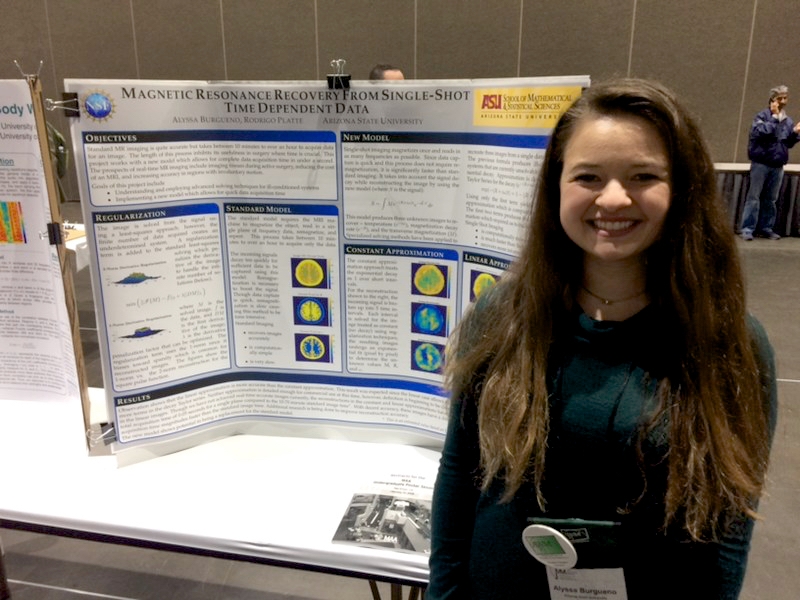Dean's Medalist excels in math — and physics

Alyssa Burgueno is the Spring 2020 Dean's Medalist for the School of Mathematical and Statistical Sciences at Arizona State University.
Editor's note: This story is part of a series of profiles of notable spring 2020 graduates.
Alyssa Burgueno is the Spring 2020 Dean’s Medalist for the School of Mathematical and Statistical Sciences.
She graduated from Arizona State University in May with concurrent bachelor of science degrees in mathematics and physics, and a certificate of cryptology.
Burgueno has an outstanding cumulative GPA of 4.03, with many of her highest grades earned in very challenging graduate level courses. She was the only undergraduate student enrolled in MAT 541, a graduate level course on p-adic numbers. The course is entirely theoretical, taught at the level of comprehensive exams for the doctoral program. Burgueno received another grade of “A.”
In addition to her outstanding classwork, Burgueno has performed impressive undergraduate research projects. In the summer of 2017, she participated in the NSF sponsored program MCTP (Mentoring Through Critical Transition Points). She conducted research on a new model for the MRI (Magnetic Resonance Imaging) signal that incorporates time dependence, under the direction of associate professor Rodrigo Platte. She presented her results at the 2018 Joint Mathematics Meeting (JMM) in San Diego, the largest gathering of mathematicians in the world.
“Alyssa has been one of the best undergraduate students I have mentored at ASU,” Platte said.
Burgueno did not originally plan to attend college. Growing up, she enjoyed math and physics, but her parents did not push her either way in terms of going to college.
With successful careers in the real estate and mortgage industry, Burgueno's parents proved as powerful examples when she was considering future choices. They expressed that a college degree is not necessary to make money or be successful, and encouraged her to have an open mind about schooling as well. She was also concerned that student loans might bury her in debt.
“I decided to just try college out for a semester, and from then on I was hooked,” Burgueno said. “Every day I learn a bit more about this deep, vast, untouchable place of math and every day I realize how much I enjoy it.”
To pay for school, Burgueno worked as a server or host at various restaurants around the valley. Her senior year she worked as a grader and instructional assistant for the school.
Burgueno tutored other students in math, physics, French, writing and history, and recorded teaching videos for a high school level online physics course. Among her many honors, she was a Golden Key International Scholar, Goldwater Scholarship nominee, and selected as a top 20 junior to attend the inaugural Jonathan D. and Helen Wexler Mathematical Sciences Junior Dinner.
She was active in building a strong community in the school of math. As a club leader, she helped to relaunch the student chapter of the Association of Women in Mathematics. She believes women are a vastly underrepresented group in mathematics, and STEM in general. and would like to build awareness and begin to reverse that trend.
"Before working with the AWM chapter, I was not aware of the struggles a lot of female students and faculty in STEM go through regularly," Burgueno said. "I think it is very important to build awareness of these struggles so we can collectively work to eradicate them."
One day in February 2018, during her MAT 442 Cryptography II class, she had an unprovoked grand-mal seizure. She had shown no previous symptoms, and had no forewarning. She woke up with a group of firefighters in the room and could not remember anything.
“The whole event was a bit traumatic, to be honest," Burgueno said. "I lost my memory for a few hours — my name, family members, where I was, what I did."
She regained memory of her identity and recent memories within a few hours, and older memories and ideas within a few days.
About six weeks later, tests came back from her neurologist. Burgueno was diagnosed with epilepsy. She manages her condition with medication, and has had only one other seizure.
After discussing with numerous doctors, Burgueno made the difficult decision to take a year off from school.
The medication prescribed for her is a mental suppressant, which essentially makes it harder for signals to pass between neural connections ensuring signals only pass if they are meant to.
Due to the suppressing nature of the drug, Burgueno found it difficult to think for months after she started the medication. She spent many months simply sleeping and just trying to get used to the medication as she recovered.
“It’s amazing how long the brain takes to recover from any changes,” Burgueno said.
She got a job in Sedona, Arizona, as a barista, and found a place to live near her work and her family.
“I really enjoyed being close to them and having a peaceful job and stress-free life.”
Returning to ASU was difficult.
She wasn’t sure if it was the medication or the year away from math, but she found the subject to be quite daunting to pick up again.
She wasn’t understanding the material well and struggled to grasp everything that was presented. This was reflected in her grades. She had to rebuild her studying stamina — and other little things, like getting used to reading often, and writing notes for a few consecutive hours.
“I would like to say math was my comfort, but I was honestly really discouraged that something I had enjoyed so much had become so difficult,” Burgueno said. “When I first came back to ASU, the homework and tests and material felt like an uphill battle rather than a fun puzzle.”
During her second semester, she was finally able to settle back into a much better routine. She was able to really enjoy the learning process — the note taking, exams, homework and all.
Previous to her diagnosis, Burgueno had been awarded the Jack H. Hawes Memorial Mathematics Research Scholarship. She was able to defer the scholarship for a year. When she returned to ASU, she again started working on her honors thesis, under the direction of Nancy Childress, associate professor of mathematics and Barrett, The Honors College faculty honors adviser.
Her research project examines p-adic numbers with an emphasis on developing theory useful for quantum mechanics.
“I am particularly interested in this research project because it uses abstract algebra extensively, but it is also incredibly enjoyable to work in such a strange world of numbers,” Burgueno said. “Many principles that seem like instinct to us are shattered or altered in this different p-adic field which leads to fascinating proofs, unintuitive results, and real promise to revolutionize areas of mathematics and physics alike.”
"Alyssa is self-motivated, curious, and quick to absorb new ideas. Her enthusiasm for learning mathematics led her to choose very difficult subject matter for her honors thesis and complete it successfully,” Childress said. “It has been a pleasure working with her. I look forward to seeing her research career develop further as she enters graduate school.”
Burgueno plans to pursue a PhD in mathematics with an emphasis on algebraic number theory at the University of Wisconsin-Madison. She also won a study scholarship through the German Academic Exchange Service, which may send her to Germany for a couple of years to work on a master's degree before returning for her PhD.
“Alyssa Burgueno is an outstanding student with a near perfect GPA in two majors, math and physics. In addition, she's completed two research projects, (one being her honors thesis, and presented both at professional conferences,” school Director and Professor Al Boggess said. “With this unusual level of achievement, it is little wonder she was selected as this year's Dean's medal in SoMSS.”
We asked Burgueno to share a bit more about her journey as a Sun Devil.
Question: What does receiving Dean's Medal mean to you?
Answer: My journey at ASU, and by extension my introduction to adulthood, has been filled with hard work and a deep appreciation for Mathematics, academia and research. While I believe I have grown greatly through my studies, there were certainly times of uncertainty and confusion. In addition, I have struggled from a number of unexpected health issues. To receive the Dean's Medal for the School of Mathematical and Statistical Sciences as a conclusion to my studies at ASU is truly a great honor. I am grateful to the many wonderful faculty who have guided me toward this achievement.
Q: What was your “aha" moment, when you realized you wanted to study the field you majored in?
A: I originally enrolled in ASU with the intent to receive a major in physics. I knew physics required a deep understanding of mathematics; thus, I enrolled in a double major with math. However, I had an “aha” moment in MAT 300 when I learned the proof that the square root of 2 was not a rational number. I found it so simple, elegant, clever and honestly beautiful. Once I got a taste of logical beauty, I was hooked and have since shifted my focus to number theory. Though I am still pursuing a degree in physics, I am mainly interested in number theory and ways to apply number theory to modern physics.
Q: What do you like most about mathematics (and your area of concentration)?
A: My favorite thing about mathematics is the certainty of logic. In many other disciplines, there is disconnect between exactly what we observe and exactly what is occurring. For example, we cannot observe quantum mechanics or the RNA process of the cell and, thus, we must rely on certain simplifications and assumptions. However, mathematics uses pure logic to prove results with absolute certainty — though, I suppose, most of modern mathematics rely on the axiom of choice.
Q: What is something you learned while at ASU in the classroom or otherwise that surprised you, that changed your perspective?
A: In my linear algebra course a number of years ago, Professor (Bruno) Welfert held up a pen and held it so only the back was visible from the audience. “From this perspective, you would think the pen is simply a point,” he illustrated as he emphasized linear algebra was all about the point of view. In a very literal sense, this has changed my perspective on a larger life scale. It can often be both fun and rewarding to analyze situations from different perspectives, to turn the picture. In fact, you often miss something if you stick to looking at an issue with the same point of view.
Q: Which professor taught you the most important lesson while at ASU?
A: Dr. (Nancy) Childress has been one of the most influential people throughout my academic career. She has shown me the beauty of mathematics and the thrill of math research. The most valuable lessons she taught me are to persevere in the face of challenges, to always give the your best effort, and failure is a part of learning.
Q: What is the best piece of advice you would give to those still in school?
A: Talk to faculty about their research interests early in your degree and find something that you would be interested in studying in depth.
Q: What do you think is most misunderstood about math by the general public?
A: There are many things misunderstood about math by the general public, predominantly resulting from inadequate math education. I think the most unfortunate misunderstanding is that many think math is a system of memorizing formulas and plugging in numbers to find an answer. However, mathematics requires extreme creativity and cleverness to create proofs and solve complicated problems — it is a series of fun and challenging puzzles where answers can actually help people. It is rarely a game of “plug-n-chug” and far more often a game of “make this canvas beautiful using only and exactly 73 colors”.
Q: What do you like to do in your spare time for fun?
A: I enjoy many things, especially outdoor activities. I do yoga in the mornings and practice the piano most evenings. I enjoy jogging and hiking with my dog. I am a novice mountain biker and enjoy the Sedona Mountain Bike Fest every year. I like to bake, but I am quite an awful cook. I also like to draw/paint outside, though I can’t say I am all that good. I suppose a day of fun would comprise a long bike ride or adventurous hike with a sketch book followed by snacks and rafting down the creek.
Q: If someone gave you $40 million to solve one problem on our planet, what would you tackle?
A: Though $40 million is a lot of money, it is not enough to solve any problem currently facing mankind. Thus, this comes down to a maximization of the funds given type of problem. Therefore, I would concentrate my efforts on supplying clean drinking water to all as I believe this can be accomplished within the budget and would create a substantial increase of average living conditions on our planet. The thought that many people sharing our same Earth do not have access to clean drinking water, one of the basic needs of survival, is quite disheartening. With some time developing more efficient water cleaning systems, such as osmosis and distilling methods, and budget to develop and implement such systems, I believe this problem could be nearly eradicated within the budget.
More Science and technology

ASU startup Crystal Sonic wins Natcast pitch competition
Crystal Sonic, an Arizona State University startup, won first place and $25,000 at the 2024 Natcast Startup Pitch Competition at…

Celebrating '20 Years of Discovery' at ASU’s Biodesign Institute
Editor’s note:The Biodesign Institute at Arizona State University continues to celebrate its landmark 20th anniversary with this…

Rocket science: Students land opportunity to create inflatable lunar pad for NASA
Editor's note: The ASU AEGIS team won the Best Systems Engineering award — one of two awards given to the six teams that…



